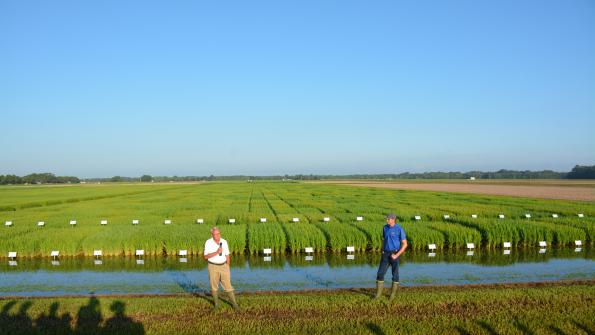December 3, 2016

Few things in agriculture are more beautiful than a flooded rice field. There’s just something about seeing acres of tall, green plants standing in tranquil bays of water to make someone glad to be a rice farmer.
But some growers are beginning to “ditch” those flooded fields in favor of a new production system that promises to use less water and – potentially – other inputs and improve their flexibility in responding to markets and government programs.
A handful of producers and rice specialists have been experimenting with furrow-irrigated or row rice ever since the Clearfield Rice System made it possible to control red rice without flooding to prevent the weeds from emerging. Now the need to save water and money is leading more growers to try it.
“I started in 2015 working with Darrell Vandeven in St. Joseph,” said Steve Crawford, a retired LSU AgCenter weed scientist and crop consultant. “Darrell spends a lot of time online, searching for new things and new challenges.
“He said we’re going to plant some rice in rows – what do you think about that?” Crawford said, speaking to a group of producers attending a Row Rice meeting in Rayville, La. “I told him ‘It suits me. Let’s give it a whirl.’”
‘Will it water?’
Dr. Crawford said Vandeven Farms planted 80 acres of RiceTec’s XL 753 hybrid under furrow irrigation in 2015. “All of my experience is with hybrid rice, and, for the early going, hybrid rice is where I would go with this if it was the first time I tried it.”
The crop was planted in soybean stubble. When the rice grew to the height when growers would normally apply a flood, the grower rolled out polypipe and began irrigating it like he would a soybean field.
“All of my row rice experience with Darrell Vandeven, Heath Herring and Rusty Ratcliff has been in a no-till or stale seed situation,” he said. “You think of rows, you don’t think of the ones the Veronis put up on the Macon Ridge that were 15 inches tall. We’re almost trenching the fields. I would say after we roll them we have a 4-inch bed maximum.
“You want just enough of a trench or ditch for the water to move. I remember asking Heath “You think it’s actually going to water?’ and he said, “Yeh, it’s going to water,’ and it did, very, very well.”
Dr. Crawford breaks weed control in furrow-irrigated rice into three sections: 1) Early pre-plant, 2) At-planting, and 3) early post, as needed. Growers should tailor their herbicide applications to the weed species present along with resistance management strategies.
‘Start clean, stay clean’
“You have to start clean, stay clean, and you must use overlapping residuals,” he said. “This is going to get us off to a good start,” he added, referring to the use of glyphosate plus 2,4-D, plus either First Shot or Afforia, depending on whether a grower wants to apply a residual herbicide or not.
“We’re seeing a lot of glyphosate- and ALS-resistant ryegrass,” he said. “Where that’s a problem, I add clethodim (Select) and crop oil for the ryegrass. Again, this needs to go out at least 30 days preplant.”
For the at-planting application, Crawford applies glyphosate and Command for grass and small-seeded broadleaves and Sharpen for large-seeded broadleaves and additional residual control.
In-crop applications include mixtures of Facet plus Stam or propanil, Command plus Stam or Grasp plus Stam with Permit added, if needed for improved nutsedge control.
“At this point, it seems to be simpler than paddy rice,” he said. “The worst thing a grower can hear is that he needs to flush his rice. In row rice, the switch on the power unit is right there so you can flush very easily.”
Dustin Harrell, Extension rice specialist with the LSU AgCenter, says most of what he knows about row rice he’s learned from talking to farmers, consultants and university specialists in Arkansas, Louisiana and Mississippi.
More research coming
“I think researchers from the University of Arkansas and from Mississippi State University will issue reports on their findings very soon,” Dr. Harrell said at the Row Rice Production Meeting held by the North Louisiana Rice Growers Association and the Richland Parish Extension Office in Rayville.
Dr. Harrell gave an audience of more than 50 farmers a recap of the current thinking on row rice and some of the potential savings and other reasons growers may want to consider using the practice during a 20-minute presentation.
He also talked about the important of avoiding blast-susceptible rice varieties if growers decide to try furrow-irrigated rice.
“Rice farmers know that if you want to get blast disease, drain the water off your rice,” he said. “Sheath blight is a disease that can reduce your yields by 30 percent. With blast, you’re lucky if you have 30 percent of your crop left when it’s done.”
Dr. Harrell displayed a list of rice varieties and hybrids recommended for Louisiana in a slide. As he removed varieties that are susceptible to blast or not suitable for row rice; i.e., medium grain, the list grew smaller and smaller until on rice hybrids and Catahoula were left.
Both Harrell and Crawford said growers should consider sticking to hybrid rice when they’re just starting out with furrow-irrigated rice.
For more information, visit http://louisianacrops.com/author/dustin-harrell/
You May Also Like




